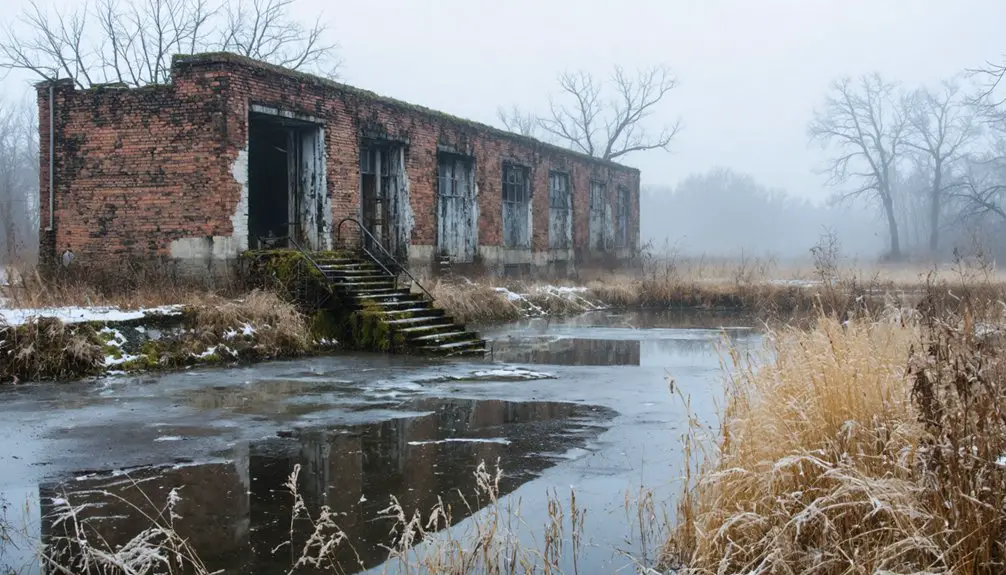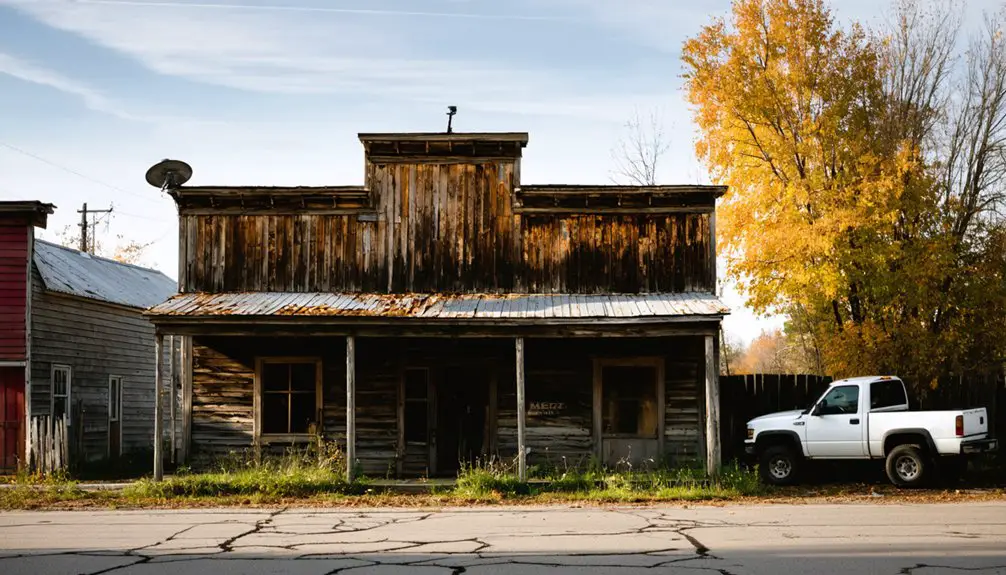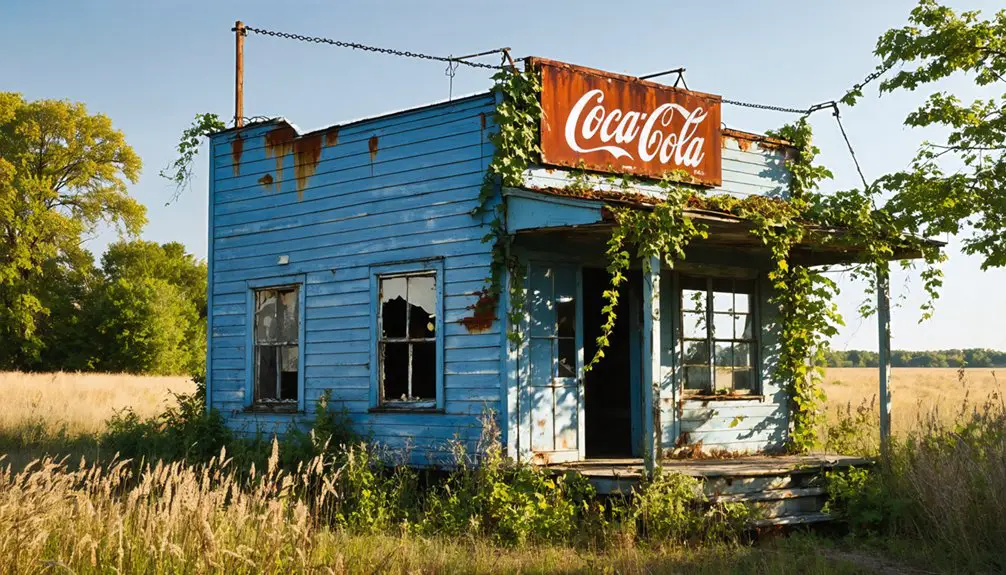You’ll find Harrietta, Michigan’s ghost town story in its dramatic transformation from an 1889 lumber boomtown. Originally named Gaston, then Harriette, this Toledo, Ann Arbor and North Michigan Railway stop once bustled with 700 residents, sawmills, and a state fish hatchery. By the 1970s, over-harvesting of white pine left just 60 inhabitants. Today’s population of 157 and abandoned storefronts tell a compelling tale of Michigan’s vanished lumber empire.
Key Takeaways
- Harrietta transformed from a thriving lumber town of 700 residents to a near ghost town after the depletion of Michigan’s old-growth forests.
- The mass exodus of lumber workers led to widespread business closures and infrastructure deterioration throughout the early 1900s.
- By 1971, Harrietta’s population had plummeted to just 60 residents, marking its status as a ghost town.
- Abandoned storefronts and historical landmarks remain as visible reminders of Harrietta’s former prosperity during the lumber boom.
- Despite ghost town status, Harrietta maintains a small population of 157 residents with an 83.3% homeownership rate.
Early Settlement and Town Origins
While numerous Michigan settlements emerged along railway lines in the late 1800s, Harrietta’s story began in 1889 when James Ashley platted the town along the Toledo, Ann Arbor and North Michigan Railway.
Harrietta became one of many Michigan railroad towns in 1889, planned by James Ashley along a critical transportation route.
The settlement patterns reflected the era’s dependence on rail transportation, with the town’s location strategically chosen for access to this essential link. This careful planning helped prevent naming ambiguity among the various Henrietta Townships that existed.
You’ll find an interesting naming history here – the town was first incorporated as Gaston in 1891, but railway officials insisted on “Harriette” in 1892, a name Ashley created by combining his father Harry’s name with his fiancé Henriette Burt.
The spelling changed once more to “Harrietta” in 1925. This evolution occurred within Henrietta Township, which itself had been organized in 1837 as West Portage before being renamed in 1839.
The local Springdale post office was relocated to serve this new community in 1890, helping establish Harrietta as a permanent postal station.
The Rise and Fall of Lumber Industry
During the lumber boom of the late 1800s, you’d have found Harrietta’s mills bustling with workers who processed the region’s abundant white pine and hardwoods. Similar to Muskegon’s operations, lumberjacks worked winters when frozen ground made tree access and transport easier.
By the turn of the century, you could see the devastating effects of over-harvesting as Michigan’s old-growth forests rapidly disappeared, leaving Harrietta’s sawmills with diminishing resources. The town, which was platted in 1889 along railroad, became a key stop for timber transport and processing.
The depletion of viable timber forced many of the town’s residents to abandon their homes and businesses, transforming the once-thriving lumber town into a shadow of its former self.
Booming Mills and Employment
Michigan’s explosive lumber industry transformed Harietta and countless other towns between 1869 and 1900, as the state led the nation in timber production.
You’d find hardy workers braving harsh lumber camp conditions – battling winter’s brutal cold while felling trees and summer’s heat with its swarms of mosquitoes.
Mill innovations revolutionized the industry as railroad access opened new territories for logging.
The ambitious New England lumbermen initially predicted the vast timber resources would sustain the industry for over a century.
If you worked in Harietta during the boom, you’d experience:
- Year-round employment opportunities in cutting, hauling, and processing timber
- Railroad jobs that connected the mills to major transportation routes
- Supporting roles in camp operations, from cooking to equipment maintenance
The mills processed millions of board feet, creating unprecedented economic opportunities that drew workers and their families to these bustling timber towns.
Resource Depletion Takes Toll
The relentless pursuit of lumber profits between 1840 and 1900 stripped Michigan’s forests bare, with over 160 billion board feet of timber harvested from the state’s once-dense woodlands.
You’d have witnessed a dramatic transformation as logging companies exhausted the valuable white pine first, then moved on to hardwoods, leaving devastated landscapes in their wake.
The sustainability challenges became evident as the industry’s short-sighted practices led to soil degradation, habitat destruction, and altered watersheds.
When timber reserves ran out, mills shut down, jobs vanished, and towns like Harrietta faced economic collapse.
While some areas converted to farmland, others were left to nature’s slow ecological restoration process.
Community Impact After Decline
Once lumber resources dwindled in the late 19th century, Harrietta’s vibrant community unraveled with devastating speed. The town’s social identity, deeply rooted in logging culture and mill operations, faced unprecedented challenges as workers and their families left in search of new opportunities.
You’ll find that Harrietta’s community resilience was tested through three major shifts:
- Mass exodus of lumber workers led to closure of essential businesses and services.
- Conversion of logging camps into abandoned spaces disrupted established social networks.
- Change from resource extraction to conservation activities, including the 1901 establishment of Harrietta State Fish Hatchery.
The town’s infrastructure deteriorated as its economic base eroded, impacting everything from postal services to schools.
While some residents adapted through small-scale farming or tourism-related work, Harrietta’s transformation into a ghost town reflected the broader industrial changes sweeping through Michigan.
Railway’s Role in Town Development
You’ll find the rise of Harietta closely tied to Michigan’s post-Civil War railway expansion, when over 8,000 miles of new track transformed the state’s northern frontier between 1865 and 1890.
The town’s early prospects improved considerably as rail connections offered essential links to larger markets, enabling the transport of lumber and agricultural goods through Michigan’s expanding network. The development mirrored the early success of the Michigan Central Railroad which began as a carrier of natural resources, particularly timber. State government involvement was crucial for early railway development, with Governor Mason securing a $5 million loan for construction projects.
Rail access positioned Harietta as a transport hub, creating temporary economic prosperity through increased employment at depots and improved trading capabilities.
Early Transport Hub Growth
During Michigan’s late 19th-century railway expansion, Harrietta emerged as an essential transport hub when the Toledo, Ann Arbor and North Michigan Railway established the town in 1889.
You’ll find that these transportation innovations transformed the heavily forested region into a thriving community, showcasing remarkable community resilience through multiple name changes and rapid development.
The railway’s impact on Harrietta’s growth manifested in three key ways:
- Created crucial connections to major cities like Detroit, Chicago, and Grand Rapids
- Enabled the establishment of industrial facilities including sawmills and wood alcohol plants
- Facilitated the installation of modern infrastructure, such as telephone services
Economic Rise Through Rail
The railway’s arrival in 1889 sparked unprecedented economic growth in Harrietta, transforming the Michigan woodland settlement into a bustling industrial center.
You’d have witnessed railroad commerce reshape the town’s identity as sawmills, stave mills, and a wood alcohol plant sprung up along the Toledo, Ann Arbor and North Michigan Railway.
Industrial growth flourished as the rail network opened new markets for Harrietta’s businesses.
You could’ve seen freight cars loaded with lumber products and manufactured goods heading to distant cities, while coal and raw materials streamed in.
The railway’s presence attracted diverse enterprises, including a stove factory, and supported the development of modern amenities like telephone service.
Legacy of the State Fish Hatchery

Michigan’s pioneering spirit in fish conservation took shape at the Harrietta State Fish Hatchery, established in 1901 as part of the state’s expanding hatchery infrastructure. This early development paved the way for the second fish hatchery at Drayton Plains in 1903.
Through hatchery innovation and advanced fish propagation techniques, you’ll find this facility played a vital role in maintaining Michigan’s reputation as an angler’s paradise. The facility operated on 47 acres of ponds across its expansive grounds.
The hatchery’s enduring impact on the region included:
- Production of millions of fingerlings, ensuring abundant fish populations in northern Michigan’s waters
- Implementation of groundbreaking fish culture practices during the Fingerling Era (1930-1949)
- Development of research-driven breeding methods that enhanced fish survival rates
As one of six modern hatcheries by mid-century, Harrietta’s legacy lives on through its contributions to conservation, recreational fishing, and the preservation of Michigan’s aquatic heritage.
Remnants of a Once-Thriving Community
Ghost towns tell powerful stories of boom and bust, and Harrietta’s remnants paint a vivid picture of this cycle.
Where once stood a vibrant village of 700 residents, you’ll now find scattered historical landmarks amid overgrown streets and empty buildings. Originally established as village of Gaston, the community underwent several name changes before settling on Harrietta. Walking through Harrietta today, you can spot foundations of former homes peeking through the grass, while Main Street’s vacant structures stand as silent witnesses to the town’s heyday.
Before World War I, you would’ve found a bustling community complete with a bank, churches, mills, and factories. By 1971, only 60 residents remained.
Though the 2020 census counted 151 people, this ghost town’s physical remnants – from abandoned storefronts to grassbound backstreets – tell the story of a once-prosperous logging community that couldn’t survive when timber ran out.
Life in Modern-Day Harrietta

Modern Harrietta stands as a small but resilient community of 157 residents, marking a subtle transformation from its ghost town status.
You’ll find community resilience reflected in the village’s high 83.3% homeownership rate and strong rural identity, where English-speaking families maintain deep local roots.
Life in today’s Harrietta centers around three key characteristics:
- A tight-knit demographic where 98.95% of residents are White, preserving traditional small-town dynamics
- Strong family values evidenced by a 59% marriage rate, with over half of families raising children
- A significant elder presence shown by the 42.4 old-age dependency ratio, shaping the community’s social fabric
Despite economic challenges, including a 17.37% poverty rate, Harrietta’s steady population growth of 0.64% since 2020 demonstrates its enduring spirit.
Frequently Asked Questions
What Happened to Harrietta’s Original Bank Building and Its Contents?
You’ll find no bank artifacts remain, and building restoration wasn’t possible – the original structure fell into disuse, likely demolished, while its contents were transferred or liquidated during Harrietta’s economic decline.
Are There Any Surviving Photographs of Harrietta During Its Peak Population?
You won’t find publicly archived historical documentation or photographic evidence from the peak population period. While the town had infrastructure suggesting photos existed, none have surfaced in accessible historical collections.
What Was the Average Wage for Lumber Workers in Harrietta?
While lumber industry wages varied widely, you’d have earned $20-26 monthly as a lumberjack or $30-50 as a mill worker in Harrietta, with wage fluctuations based on job type and season.
Did Any Notable Crimes or Mysteries Occur in Harrietta’s History?
You won’t find any notable incidents or unsolved mysteries in the historical records of Harrietta’s past. Unlike other Michigan ghost towns, its decline stemmed purely from economic factors and resource depletion.
Which Families Have Lived in Harrietta Continuously Since Its Founding?
You’ll find it challenging to definitively identify founding families with continuous residence, as historical records don’t clearly document multi-generational settlement patterns beyond the Ashley and Burt families’ initial involvement.
References
- https://mymagicgr.com/ghost-towns-michigan/
- https://www.nailhed.com/2015/10/what-to-do-with-old-ruins.html
- https://en.wikipedia.org/wiki/Harrietta
- https://www.geotab.com/ghost-towns/
- https://lostinmichigan.net/harrietta/
- https://kids.kiddle.co/Harrietta
- https://en.wikipedia.org/wiki/Henrietta_Township
- https://wexfordcountyhistory.org/history/
- http://genealogytrails.com/mich/jackson/henriettatwp.html
- https://mff.forest.mtu.edu/PDF/1-TreeBasics/3-History.pdf



